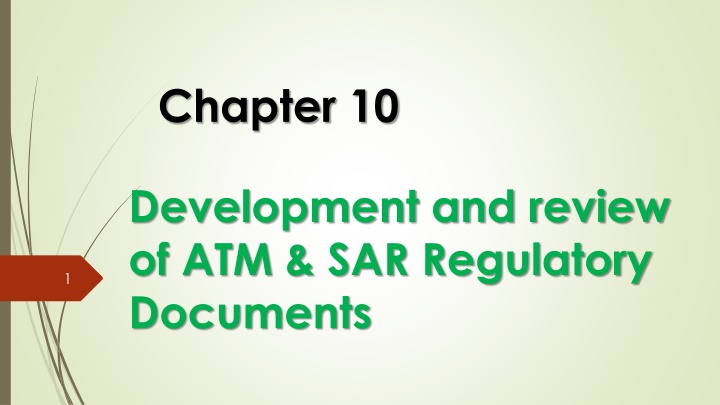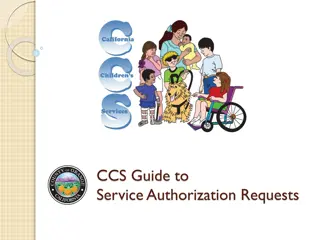Importance of Developing and Reviewing ATM & SAR Regulatory Documents
Regulations serve to ensure safety and efficiency in civil aviation, providing a framework for inspectors to oversee safety practices. It is crucial for regulators to develop and update regulations promptly to align with international standards and stakeholder input, emphasizing the need for technical guidance materials to support inspectors in their oversight functions.
Uploaded on Aug 23, 2024 | 2 Views
Download Presentation

Please find below an Image/Link to download the presentation.
The content on the website is provided AS IS for your information and personal use only. It may not be sold, licensed, or shared on other websites without obtaining consent from the author.If you encounter any issues during the download, it is possible that the publisher has removed the file from their server.
You are allowed to download the files provided on this website for personal or commercial use, subject to the condition that they are used lawfully. All files are the property of their respective owners.
The content on the website is provided AS IS for your information and personal use only. It may not be sold, licensed, or shared on other websites without obtaining consent from the author.
E N D
Presentation Transcript
Chapter 10 Development and review of ATM & SAR Regulatory Documents 1
Why Develop and Review 2 Regulations provide regulated entities with requirements to be complied with in order to assure safety and efficiency of civil aviation. To ATM & SAR inspectors, regulations provide the framework under which the safety oversight system works. This therefore underscores the importance of complete, relevant and up to date regulations. For this reason, ATM & SAR inspectors need to ensure that regulations are as current as possible at all times.
Development of Regulatory Documents Development of Regulatory Documents 3 States should develop and implement a process to ensure the timely development and amendment of the specific operating regulations, necessary in order to keep pace with amendments to Annexes to the Convention. Additionally, sufficient guidance material provides guidance to technical personnel and allows management to ensure that safety oversight functions and activities are carried out in an effective and standardized manner.
Development of Regulatory Documents Development of Regulatory Documents 4 The CAA s specific operating regulations should conform with the Annexes to the Chicago Convention; The adoption of requirements shall be as contained in the annexes regardless of the size and complexity of their civil aviation activity; Only non applicable provisions should be avoided;
Technical Guidance Material 5 Technical guidance material is meant to enable ATM & SAR Inspectors perform their safety oversight function in accordance with established requirements and in standardized manner. This includes the provision of technical guidance to the ANSP on implementation of applicable regulations and instructions. States need to develop and publish their own technical guidance material to assist in the implementing national regulations, procedures and practices. ATM & SAR inspectors have a duty to ensure that all guidance is provided and that applicable TGMs are reviewed at regular intervals.
Development of TGMS Development of TGMS 6 Developed and availed to inspectors to enable them to perform their safety oversight functions effectively and in a standardized manner; Developed immediately after the review and promulgation of regulations; Necessary to subject the draft to stakeholders input before approval.
Technical Guidance Material 7 The following documents form part of TGMs. ANS Inspectors handbook Advisory circulars Orders ANS Technical standards Applicable forms and checklists
Importance of reviewing Audit Documents 8 a) b) c) minimize risks associated with use of outdated material; increase operational excellence; ensure that inspectors have the information to do their respective assignments well; ensure inspectors are using accurate instructions and procedures; boost the Authority s preparedness for USOAP audits by ICAO; and comply with international requirements and best practices. d) e) f)
Review of ANS Regulations and TGMs 9 It is the responsibility of a State to develop and implement a process to ensure the timely amendment of the specific operating regulations; need to revise or amend Regulations may be occasioned additionally by any of the following;
Review of ANS Regulations 10 a) Upon receipt and assessment of amendments to relevant ICAO Annexes and PANS Upon amendment to Civil Aviation Act/Code Upon receipt of request/information from stakeholders regarding the application and/or implementation of the regulation; Whenever there is a significant change in the size and complexity of the aviation system; Whenever there is change in technology; When the regulations are no longer relevant, applicable or effective; As may be desired by the Authority to enhance efficiency of the safety oversight b) c) d) e) f) g)
Review of TGMs 11 The TGMs may be amended or revised when need arises owing to the following reasons: a) Upon amendment to Civil Aviation Regulations that require amendment of TGMs; b) Whenever there is an operational or environmental requirement; c) Concern raised by the industry in interpretation and/or accuracy of TGMs; d) Whenever there is a change in technological such as introduction of new equipment e) When it is no longer relevant, applicable or effective.























